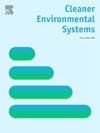Assessing greenhouse gas emissions in hospitals: The development of an open-access calculator and its application to a German case-study
IF 4.9
Q2 ENGINEERING, ENVIRONMENTAL
引用次数: 0
Abstract
Hospitals are major contributors to climate change. It is therefore essential to identify the main sources of hospitals’ greenhouse gas (GHG) emissions to develop and monitor mitigation measures. Yet, a transparent and comprehensive hospital-specific GHG accounting methodology is currently lacking. We have developed a hybrid methodology that follows the GHG Protocol Corporate Accounting and Reporting Standard to calculate emissions. We used bottom-up approaches to scope 1 and 2 and, where feasible, to scope 3. Due to data scarcity, we used top-down approaches for several scope-3-categories. As a case study demonstration, we applied this methodology to a German university hospital: Scope 3 accounted for the majority of GHG emissions (164,529 t CO2e (71%)), while scopes 1 (6008 t CO2e (3%)) and 2 (60,565 t CO2e (26%)) contributed less. Methodological challenges remain, such as a limited accuracy and monitoring options for top-down approaches. Nonetheless, this case study demonstrates that the developed methodology supports hospitals in measuring GHG emissions as part of their regulatory requirements and responsibility to safeguard planetary health.

评估医院的温室气体排放:开放获取计算器的开发及其在德国案例研究中的应用
医院是造成气候变化的主要因素。因此,确定医院温室气体(GHG)排放的主要来源,以制定和监测缓解措施至关重要。然而,目前缺乏透明和全面的针对医院的温室气体核算方法。我们开发了一种混合方法,该方法遵循温室气体议定书企业会计和报告标准来计算排放量。我们对范围1和2使用了自底向上的方法,如果可行的话,还对范围3使用了自底向上的方法。由于数据稀缺,我们对几个范围3的类别使用了自顶向下的方法。作为案例研究示范,我们将此方法应用于德国一所大学医院:范围3占温室气体排放量的大部分(164,529吨二氧化碳当量(71%)),而范围1(6008吨二氧化碳当量(3%))和范围2(60,565吨二氧化碳当量(26%))贡献较少。方法上的挑战仍然存在,例如自上而下方法的准确性和监测选项有限。尽管如此,本案例研究表明,所制定的方法支持医院测量温室气体排放,作为其监管要求和维护地球健康责任的一部分。
本文章由计算机程序翻译,如有差异,请以英文原文为准。
求助全文
约1分钟内获得全文
求助全文
来源期刊

Cleaner Environmental Systems
Environmental Science-Environmental Science (miscellaneous)
CiteScore
7.80
自引率
0.00%
发文量
32
审稿时长
52 days
 求助内容:
求助内容: 应助结果提醒方式:
应助结果提醒方式:


